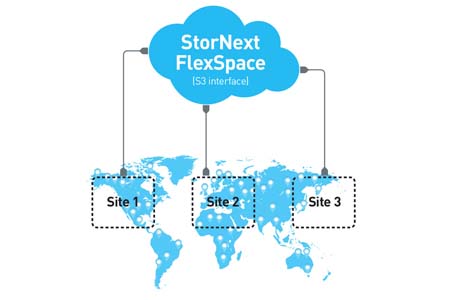Current data management technology has made multipoint content synchronisation a set-and-forget convenience, writes Keith Lissak, Senior Director, M&e solutions Marketing at Quantum.

Solutions Marketing at Quantum.
Current data management technology has made multipoint content synchronisation a set-and-forget convenience, writes Keith Lissak, Senior Director, M&E Solutions Marketing at Quantum.
Data protection has been a key element of storage system design since the earliest days of video production. For that matter, even the first filmmakers took pains to protect their negatives and edited masters. Today, data protection goes hand in hand with disaster recovery (DR) as a means to ensure the ongoing availability of mission-critical content, no matter what befalls it.
Broadcast and post-production operations particularly episodic television, commercials and features are especially contingent on tight schedules, with no room for downtime. For such operations, data protection and DR are the insurance essential to minimising downtime and staying on schedule and on budget.
Beyond RAID
Reliance on redundant array of independent disks (RAID) has long played a central role in protecting against data loss, but todays media-centric companies are looking at other ways to avoid loss of precious content. Whether it’s a drive going down or a true catastrophe such as a hurricane, flood, earthquake or fire, content creators must have a way to back up and retrieve digital media that it simply cant afford to lose. In many cases, the best way to do that is to maintain storage infrastructure at a second site geographically removed from the primary post facility, headend or broadcast station. This location could be in a different part of town, or in another city altogether. The cloud is increasingly a viable option as well.
Whether back-up is at a second site or on the cloud, the value of the data protection and DR model depends largely on timely, accurate synchronisation of content across the primary and back-up systems. Given all the time, effort and money that go into creating an episodic television show, or any other original content, the loss of just a days work can be painful, and the further loss associated with potential ad revenues can add significantly to this pain. To prevent this scenario, content creators must have a means of keeping duplicate content up to date so that in the event of a disaster, it is possible to quickly return to a recent version and get back to work with minimal downtime.
Ensuring the availability of content across sites is becoming easier with the maturation of tiered storage and data management technologies. Several key advances are giving media companies the ability to establish robust storage ecosystems equipped with vital data protection and DR capabilities.
Sustainable sync process
First among these advances is synchronisation of even very large file systems across physical sites. It was once necessary for the file system or third-party management tool to query the entire file system before changes could be determined, but this approach became unsustainable as digital media systems and file systems grew to unprecedented sizes the sync process simply took too long.
By creating a replica of the source file system on the remote destination, however, technology suppliers have gotten around this problem. By constantly monitoring and analysing metadata, the data management system supporting the entire infrastructure can update only the content that needs to be updated. Thus, while initial deployment of a synchronisation solution might take some time, the subsequent incremental changes take very little time and bandwidth, enabling highly efficient maintenance of up-to-date content.
In effect, current data management technology has made multipoint content synchronisation a set-and-forget convenience, with single-button recovery of synced files from remote sites. Files are automatically copied from the primary location to other sites to enable file recovery or to facilitate restoration of older versions of a file that may have been corrupted. Media companies can easily create one-to-one, one-to-many and many-to-one file-replication models and configure them to operate at almost any level: specific files, specific folders or entire file systems. Flexible configuration allows granular synchronisation, seeded from any source (USB, tape, NAS, etc).
When set to create point-in-time copies of files, the most reliable data protection systems allow editors, visual effects artists and other creatives to go back to any point an hour, a day or a week ago to access the version they need. With synchronisation set for specific sources at specified time intervals, the system automatically pushes copies of files out to one or Keith Lissak is senior director, M&e solutions Marketing at Quantum. more sites. Larger media companies can use this model not only to protect and preserve content, but also to make it available to teams working at different facilities.
Cloud as an archival tier
Media companies can also choose the cloud as a storage tier supporting data protection and DR. In this case, the cloud either public or private can be leveraged much like any physical location. Todays data management systems make it easy for users to integrate existing public-cloud storage accounts from the likes of Amazon Web Services, Microsoft Azure and Google Cloud, with third-party object storage (private cloud) as a back-up or archive tier.
Though data security is a legitimate concern for content creators and broadcasters, the cloud is becoming increasingly trusted for both processing workflows and storage. The giants of the cloud storage world have put their tremendous resources toward guaranteeing the integrity of content entrusted to them, and private cloud solutions naturally benefit from the same protections instituted for on-premise storage infrastructure.
While its true that pulling content down from a public cloud service can be costly, the relatively low cost of storage up until that point makes the cloud a solid choice for maintaining secure, accessible copies of valuable content. The cost of accessing that content will likely be worth it in the unlikely event of a catastrophe.
Disasters can strike at any time without notice, and it is essential that media companies protect their assets. In the era of digital media, those assets are intangible; gone are the days of film canisters hidden away in an underground vault, or videotapes secured in a climate-controlled, fireproof facility. Protecting content and ensuring that it can be quickly restored therefore requires careful planning. Todays solution relies on highly automated file movement, back-up and management, which together give media companies valuable peace of mind confidence that they can continue operations even through a natural disaster or other catastrophic event.










































































